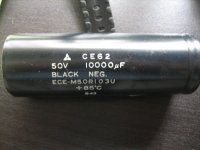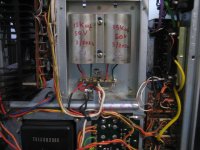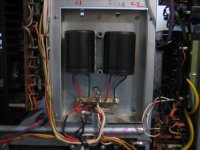My intention is to modify and install a terminal strip ( riveted or screwed to the chassis ) to accommodate the wires so only one connection to each terminal on the caps. I did not know of those cap rings so thank you for the link and the photos.
If you go with snap-in caps, I would consider making a little circuit board for the caps. Then put screw terminals on the board or solder the wires directly to the board.My intention is to modify and install a terminal strip ( riveted or screwed to the chassis ) to accommodate the wires so only one connection to each terminal on the caps. I did not know of those cap rings so thank you for the link and the photos.
Keystone #8191 could maybe work.
Tom
UPDATE: The new switch arrived today and I installed it with the existing snubber. In addtion to the power wires I installed the other two wires , red and yellow in colour, to the other two terminals on the switch. The replacement that was removed only had two terminals with the snubber across them. The result is that turning off the unit now does NOT produce the loud pop in the loud speakers as before. Also I can hear the relay click "off" immediately when the unit is turned off. So now that this is behind me , the next step is to replace the two leaky power capacitors.
Thank you all for your contribution to this thread.
Paul
Thank you all for your contribution to this thread.
Paul
Last edited:
You were spot on! The new switch solved the issue! Thanksaccording to the schematics in service manual the relay should be unpowered by a second set of contacts in the power switch.
It wasn't until I removed the caps that I saw the labelling on the cap for the polarity.it should say on the can which terminal is which.
Attachments
All done now and the amplifer is still working fine. Seems like the bass is tighter. Not the best job but functionally it is fine . Lots of redundancies for the chassis ( gnd) connections as you can see. Also with the terminal strip , should any of those caps need changing it will be a simple matter of desoldeing just two wires at the pins. The inner three terminals are all tied together for the ground. Thanks again eaveryone.
Attachments
Well, in that case the whole internals should be replaced by some digital gadget 😉That tells you something about the improvements in that technology over the past few decades.
Of course, a "digital" speaker has not yet been invented.HA! Nah... Analog still rules in many arenas. 🙂
Tom
If the rectifier diodes were defective would the amplifier still function? Do the diodes degrade with time or do they just go bad instantly?I have had cases where the rectifier diodes were defective and caused the dielectric of the capacitors to fail. It wouldn't hurt to check on them, good job.
How did the caps look visually? One would assume a blow-up.cases where the rectifier diodes were defective and caused the dielectric of the capacitors to fail.
If there was no blow-up, how did you determine that the caps had failed?
Rectifier diodes can leak, not just the two options, namely conduction or non-conduction. That was the case, a small reverse current that did not allow the complete charging and discharging of the capacitors in each half cycle. Answering your question, the amplifier may continue to work, but there are abnormalities. They can fail in either of the two ways you mention, due to use, aging, current peaks exceeding its specifications, etc.If the rectifier diodes were defective would the amplifier still function? Do the diodes degrade with time or do they just go bad instantly?
There was no explosion or leakage, they simply recharged twice when the amplifier was turned off, the typical plop you hear in amplifiers without relays. To prevent new problems, the four capacitors were replaced with slightly more capacity. (very little) It was a NAD 3020How did the caps look visually? One would assume a blow-up.
If there was no blow-up, how did you determine that the caps had failed?
Autocorrection
" There was no explosion or leakage "
It should say "electrolyte loss", since the word leak refers to the current that passes through the diode. These language translators are not perfect, ha!
" There was no explosion or leakage "
It should say "electrolyte loss", since the word leak refers to the current that passes through the diode. These language translators are not perfect, ha!
How did you establish that?they simply recharged twice when the amplifier was turned off,
- Home
- Amplifiers
- Solid State
- Marantz 1070, Loud pop on shutdown


